Wine’s influence during the Renaissance is a captivating chapter in history, intertwining with cultural evolution and the spread of ideas. During this era, wine was more than merely a beverage—it served as a symbol of status and sophistication, savored by nobility and thinkers alike.
Its significance was bolstered by the innovations of the time, which saw the development and propagation of winemaking techniques. As you explore the historical depth of wine, you uncover its crucial role in societal structures and global exploration, bridging gaps between distant worlds.
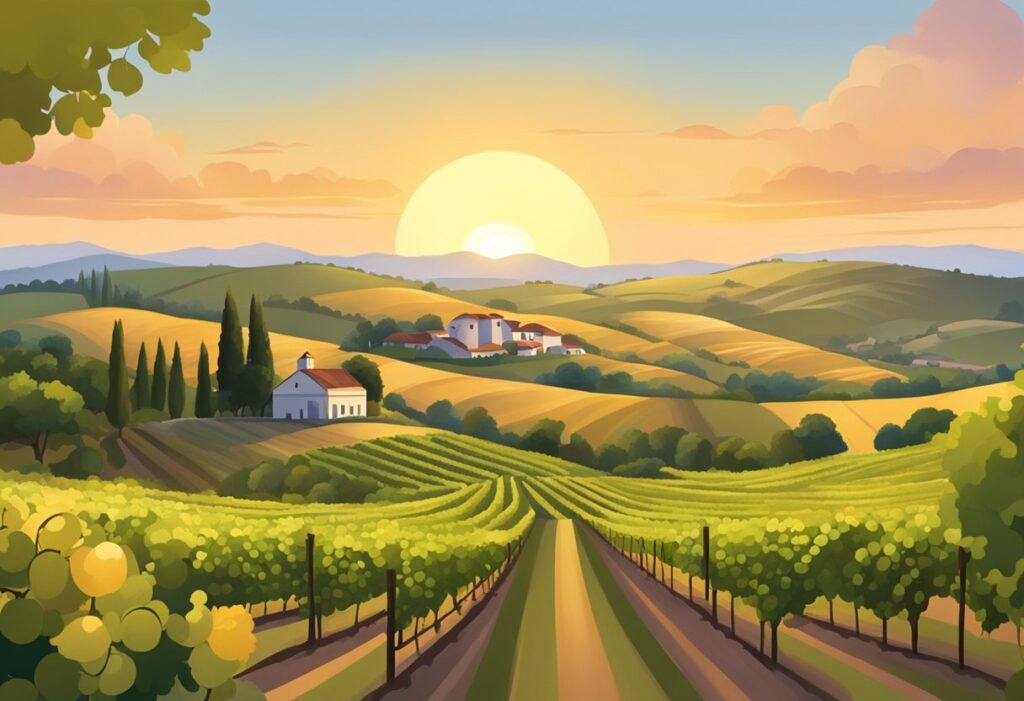
In the wake of the Renaissance, wine became a medium for exchange and a motive for exploration. Adventurers and merchants ventured to establish new routes for the wine trade, contributing to economic growth and intercontinental connections.
The relentless pursuit of new territories for vine cultivation led to the discovery of distinctive terroirs, marking the beginning of winemaking in regions that today are celebrated for their unique varietals.
Your appreciation of wine extends beyond taste, delving into the realms of politics, culture, and innovation, revealing the beverage’s extraordinary journey through history.
Key Takeaways
- Wine was a symbol of refinement during the Renaissance, shaping social and cultural norms.
- Exploration expanded the wine trade, promoting economic development and discovering new terroirs.
- Winemaking advancements during this period laid the groundwork for today’s wine industry.
Historical Roots of Wine
Your understanding of wine’s heritage enriches your appreciation of its cultural significance. Wine has been more than a beverage; it’s a historical artifact that reflects the practices and values of the civilizations that cherished it.
Wine in Ancient Civilizations
Ancient civilizations, especially Georgia and Egypt, played pivotal roles in the genesis of wine culture. In Georgia, evidence of vinification traces back to 6000 BC, identifying this region as one of the earliest known sites of wine production.
Relics from these times reveal the use of V. vinifera, the principal grape species still in use today, illustrating the long-standing relationship between humans and wine. Similarly, in Egypt, wine became a symbol of status and was often included in burial rituals as a luxury for the afterlife.
Medieval Europe and Wine
Transitioning into the Middle Ages, wine’s narrative weaves through the fabric of European society. The Roman Empire had already established vineyards across Europe, a legacy that medieval societies maintained.
The period saw the rise of Christianity and the Catholic Church, both of which endorsed wine for its role in religious rituals. Monastic orders became the keeper of viticultural knowledge, advancing wine-making techniques while serving both spiritual and practical needs.
Renaissance: Wine and Advancements
The Renaissance marks a significant era in the evolution of wine with technological and cultural advancements. During this period, improved vinification practices emerged, enhancing the quality and diversity of wine.
Vineyards spread, and wine became accessible beyond the aristocracy, intertwining with daily life and celebration. The period also signified a time where explorers ventured to new worlds, carrying V. vinifera with them, setting the stage for the global wine industry we recognize today.
Evolution of Winemaking Techniques
As you explore the history of wine, you’ll discover that each period brought significant advancements in winemaking. These innovations have refined the art and science of wine production, leading to the quality and variety we enjoy today.
Innovation in the Middle Ages
The Middle Ages marked a pivotal era for winemaking, characterized by monastic contributions to the craft. Monasteries became centers for viticultural knowledge, amassing large vineyards and developing consistency in wine production.
They introduced techniques like gravity-fed presses, enhancing the pressing process and improving wine quality. Learning from monastic traditions can provide insight into these practices. Discover medieval wine traditions.
Scientific Progress in Fermentation
Fermentation is the cornerstone of winemaking, where sugar transforms into alcohol. In the era of Enlightenment, the science behind fermentation was demystified, with yeast identified as the key agent.
This pivotal understanding led to controlled fermentations, allowing winemakers to produce wines with desired strengths and flavors consistently. Recognizing the importance of yeast in fermentation was a revolution in winemaking science.
Industrial Revolution’s Impact
The Industrial Revolution brought about profound changes. As technology advanced, so did the ability to mass-produce and bottle wine. Mechanization and innovations, such as the bottle cork and the introduction of glass bottles, led to larger scale production and distribution.
This era brought wine to a broader audience while ensuring product quality through better storage and transportation methods. Explore how wine evolved in the Middle Ages.
The evolution of winemaking techniques is a testament to human ingenuity, from the Middle Ages to the modern-day. Each step reflects an ongoing pursuit for perfection, harnessing the best that science, innovation, and technology have to offer.
Wine and Society
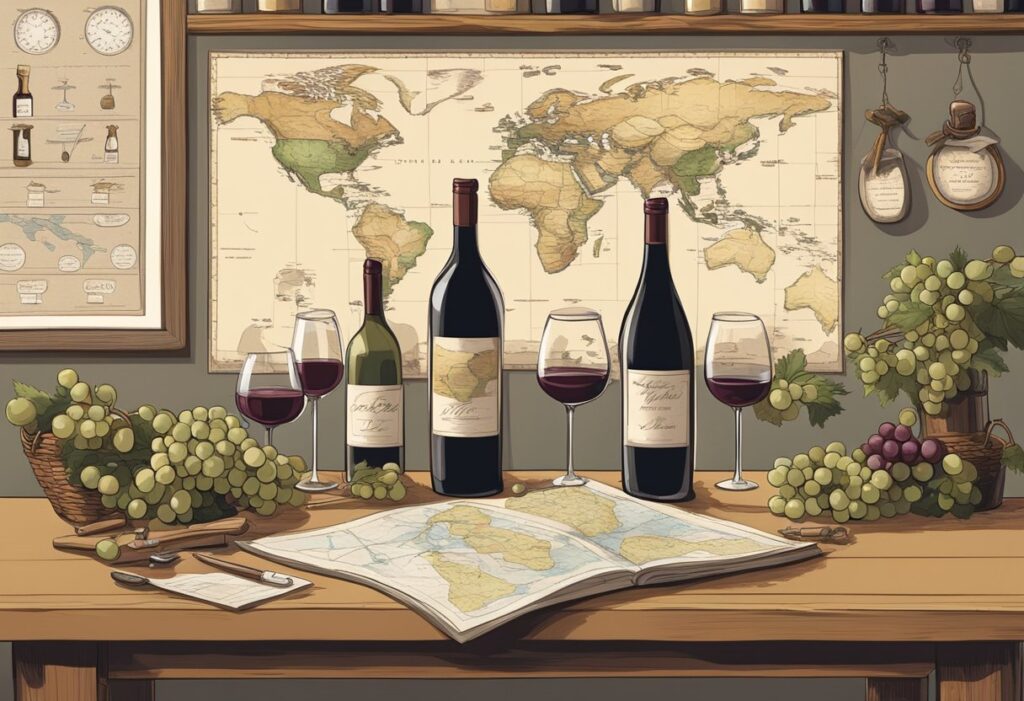
In examining the role of wine throughout history, it’s clear that its impact on society extends far beyond mere consumption. From religious rituals to being a marker of status, wine has intertwined with key cultural facets including religion, art, and literature.
Wine in Religious Ceremonies
For centuries, wine has been central to religious ceremonies. In Christianity, wine represents the blood of Christ during the Eucharist, a sacrament observing Jesus’ Last Supper.
The transformative nature of wine from a simple beverage into a holy symbol demonstrates its profound significance in faith and spirituality. Traditions such as the Greek god Dionysus celebrations and the Roman Bacchanalia festivals are earlier instances of wine’s deep connection with the divine, with rituals that celebrate its intoxicating effects reminding you of the beverage’s ancient sacredness.
Wine as a Symbol of Status and Wealth
Wine has consistently been a symbol of status and wealth. During the Renaissance, it was a privilege of the aristocracy, reflecting one’s sophistication and social standing. This phenomenon was not only prevalent in Europe but also visible in the expansion of vineyards in the New World, where possessing wine became a marker of a flourishing settlement.
Your understanding of status and affluence in society often aligns with the ownership of fine wine collections, showcasing wealth through cellars boasting rare vintages.
Wine in Literature and Art
Lastly, the fusion of wine with literature and art is undeniable. As a muse for poets and painters alike, wine has colored the world of creative expression. Literary works and philosophical texts from antiquity to the modern era frequently reference wine, using it as a metaphor for life’s complexities.
In film and visual arts, scenes depicting wine often serve as a backdrop for critical moments, illustrating its inseparable role in narrating human experiences. Your appreciation of art sometimes finds wine at its core, embodying luxury, earthly pleasures, or even transient beauty.
Global Wine Trade and Economy
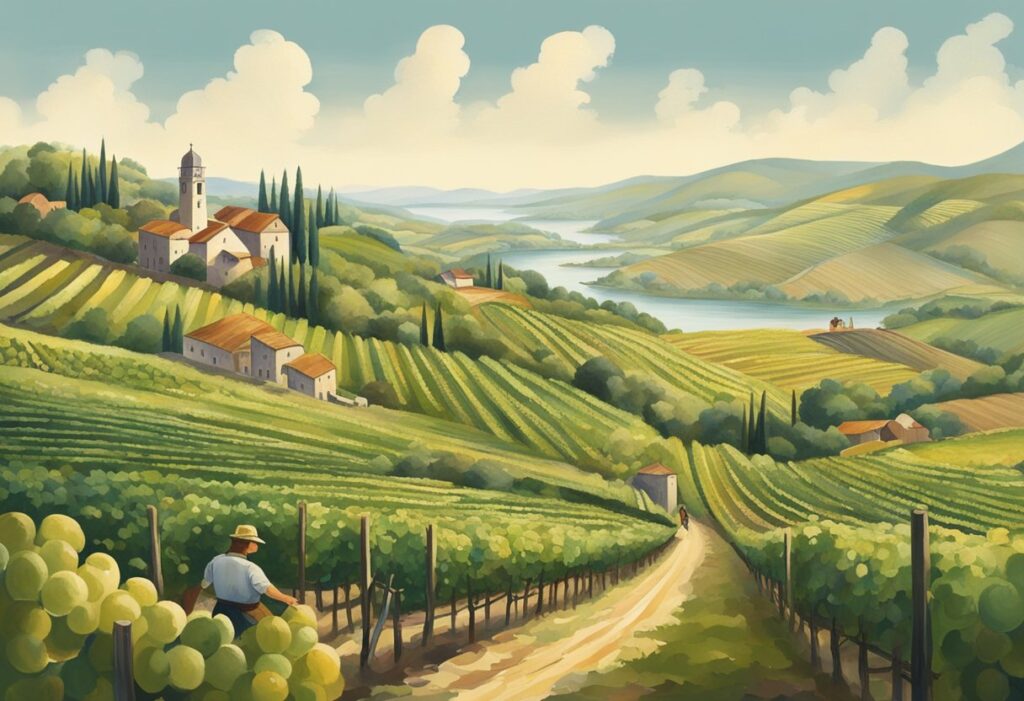
In this section, you’ll learn about the complexities of wine trade and its impact on global economies, focusing on specific countries that play pivotal roles in the wine industry.
Wine Trade in Europe
Europe’s wine trade has long been dominated by countries like France, Spain, and Italy, which are considered traditional wine powerhouses. France’s Bordeaux and Champagne regions, for instance, have set high standards for wine quality, influencing wine trade regulations and economic success.
Interestingly, ancient practices like shipping wine in amphorae were precursors to modern trading methods. In England, the demand for wine has made it a significant importer, particularly from French vineyards. The Netherlands, known for its historic trade networks, has been a crucial entry point for wines into Northern Europe.
New World Wine Expansion
Moving away from European shores, countries like the United States, Australia, Chile, and Argentina represent the “New World” in wine production. The United States, with regions like Napa Valley and Sonoma County in California, has emerged as a wine producer with a solid reputation.
Australia has carved a niche with its Shiraz, while Chile and Argentina are known for their excellent value-to-quality ratio, especially with varieties like Cabernet Sauvignon and Malbec, respectively.
Modern Wine Economy
Today’s wine economy is a tapestry of traditional methods meeting innovative techniques. With more nations importing and exporting wine, international trade agreements and economic policies significantly shape the industry.
The adoption of efficient transportation and logistics has been essential for countries like the United States and Australia to become prominent figures in the global wine economy. Meanwhile, Spain continues to be a valuable player in the European wine trade due to its vast vineyard area and production capabilities.
Influence of Politics and Law on Wine
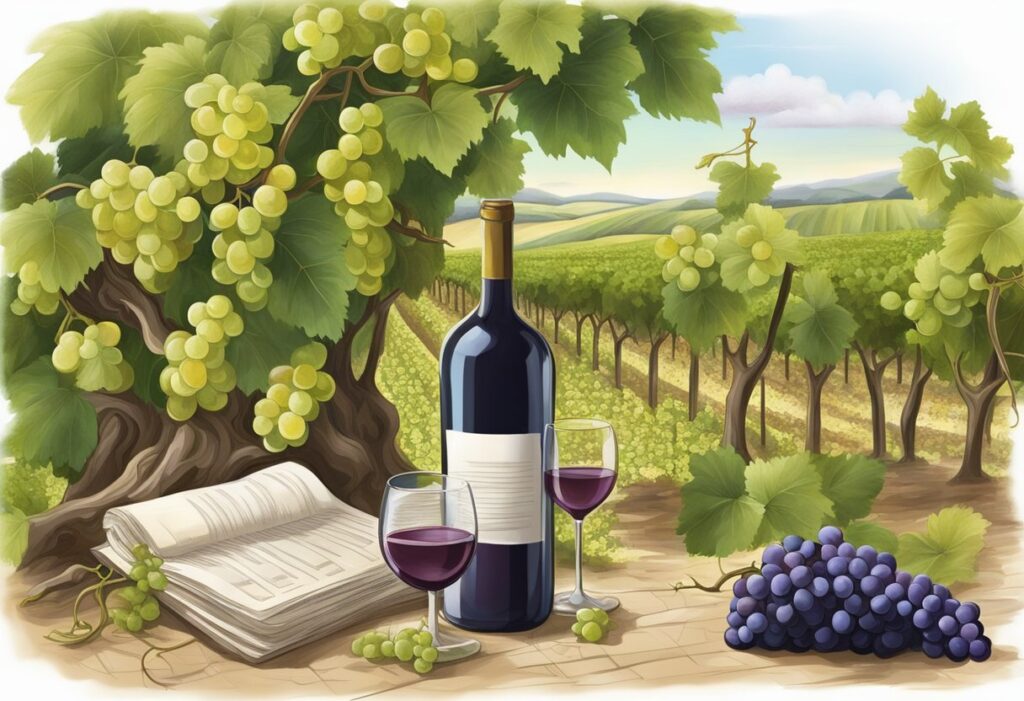
The complex interplay of politics and law has deeply influenced the wine industry throughout history, from the impact of major conflicts to the formation of nations.
Wine During Major Conflicts
During World War I, the French wine industry faced significant challenges. Battles ravaged some of the most prestigious vineyards, and troops consumed large quantities of wine for sustenance and morale. In this time of strife, wine became a scarce commodity, reflecting the broader impact of war on society and economies.
Legal Standards and Regulations
Your understanding of wine must include the legal standards and regulations that govern its production. From the Supreme Court’s decisions affecting commerce to medieval wine laws, these legal frameworks play a critical role in shaping the wine you enjoy.
For instance, the establishment of appellations standardized wine quality and authenticity, a practice that continues to the present day.
Wine and Nation Building
Thomas Jefferson and George Washington were not just American Founding Fathers but also wine enthusiasts who appreciated its cultural and economic potential. Their influence helped establish wine as part of the nation’s heritage.
The drafting of the Declaration of Independence symbolized the beginning of a democracy that would, among other things, come to legally protect the production and trade of wine as an embodiment of its evolving identity.
Cultural Impact of Wine
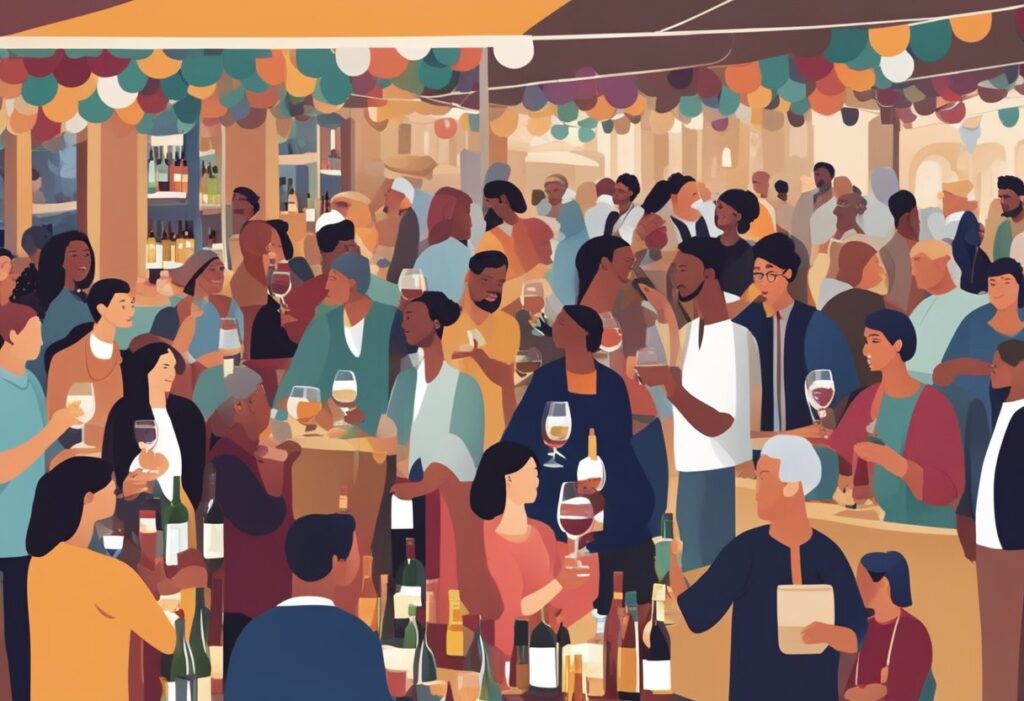
The influence of wine on social dynamics and cultural traditions is both profound and multifaceted, touching upon everything from social gatherings and feasts, to etiquette, sophistication, and the fostering of unity and friendship.
Wine in Social Gatherings and Feasts
Wine has long played a central role in social gatherings and feasts, serving not just as a beverage but as a symbol of celebration and togetherness. Events like harvest feasts would see local communities coming together, often led by religious groups like the Benedictines and Cistercians, who were instrumental in developing European viticulture.
Your experience of traditional celebrations is often marked by the communal sharing of wine, reinforcing both social bonds and a sense of collective identity.
Wine Etiquette and Sophistication
The development of wine etiquette is a testament to wine’s role in cultivating sophistication within society. You might notice how wine tasting involves a certain decorum—observing the color, swirling the glass, sniffing the bouquet, and finally, sipping and savoring the flavor.
Such rituals not only enhance the enjoyment of wine but also signal a broader appreciation for the finer aspects of culture and life. This reverence for protocol illustrates the elevation of wine to an art form, reflective of both personal taste and social status.
Wine’s Role in Unity and Friendship
Beyond its social aspect, wine has been a catalyst for unity and friendship. Sharing a bottle of wine can serve as a gesture of goodwill or as a means to seal pacts and alliances.
The act of toasting to one’s health or success with wine has woven itself into the fabric of many cultures, symbolizing a shared experience that transcends personal differences. Your personal celebrations and milestones often feature wine as a unifying element that fosters a sense of camaraderie and belonging.
Winemaking Regions and Their Terroirs
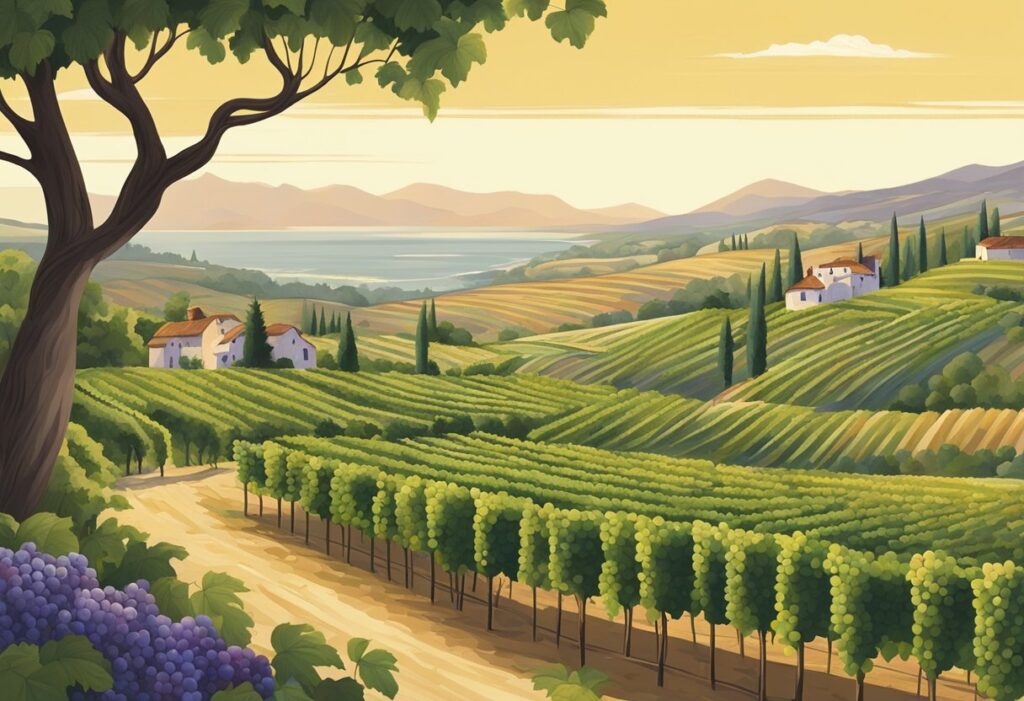
As you explore the world of wine, you’ll discover that each winemaking region offers a unique expression of terroir, allowing for a diverse tapestry of flavors and characteristics in every bottle.
French Domination in Wine Regions
France sets the standard for defining terroir, given its long-established wine culture. Notably, regions like Bordeaux and Burgundy have become almost synonymous with high-quality wine production.
Bordeaux is famed for its robust red wines, often a blend of Cabernet Sauvignon and Merlot, expressing the deep gravel soils and maritime climate. In contrast, Burgundy is revered for its Pinot Noir and Chardonnay, with vineyards reflecting the subtle nuances of the region’s limestone-rich soil.
The Rise of Wine Regions in The Americas
In the United States, California leads as a premier wine-producing region, where the varied climate and topography offer a wide range of terroirs. The United States boasts diverse vineyards that skillfully intersect the art of winemaking with specific regional characteristics.
Further south, countries like Argentina and Chile have made significant marks on the wine map. Argentina’s Malbec and Chile’s Carménère have become iconic, benefiting from the Andean mountain soils and favorable climates.
Emergence of New Wine-producing Countries
Beyond the Old and New Worlds, you’ll find an exciting emergence in regions across the globe. South Africa, for example, with its Mediterranean climate, has developed a reputation for both red and white wines that reflect the country’s complex geology and coastal influences.
As you journey through these new wine-producing countries, you’re encountering the growth and diversity of global winemaking, where each region’s terroir is meticulously expressed in its wines.
Notable Varietals and Their Histories
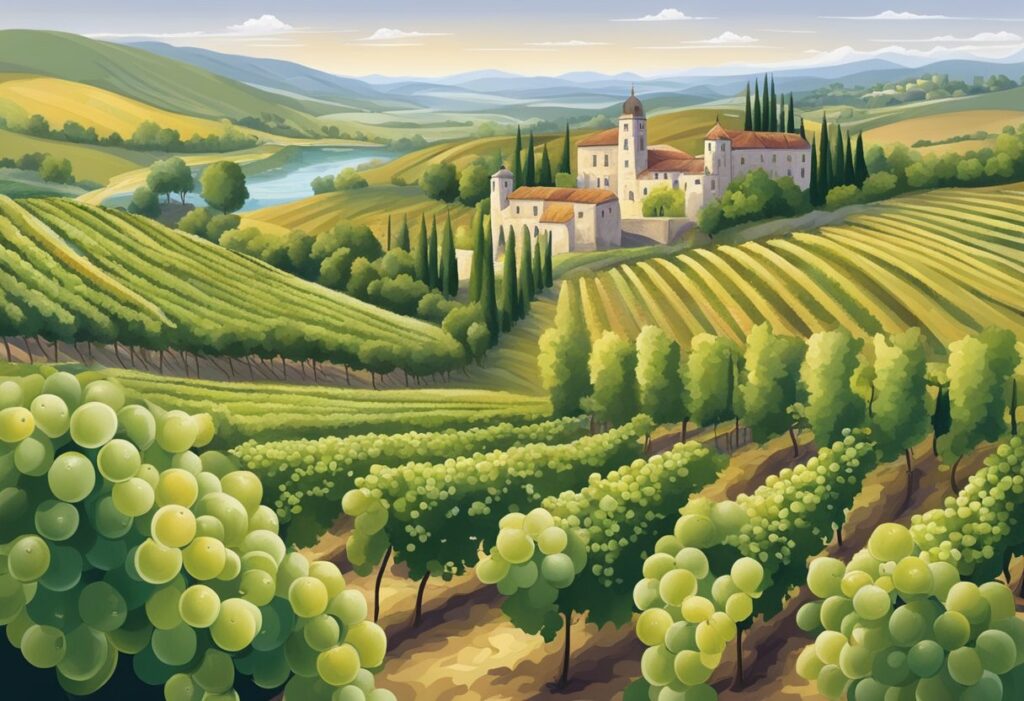
In the rich tapestry of wine history, certain varietals stand out for their profound impact on viticulture and the global wine market. You’ll discover how these grapes shaped wine regions and preferences over the centuries.
Era of Bordeaux’s Cabernet Sauvignon
Cabernet Sauvignon, the cornerstone of Bordeaux, is a grape as robust as its reputation. A late ripening variety, you’ll find it thrives in the Medoc where it gained prominence for producing full-bodied, tannic wines that age gracefully.
Historically, its rise is linked to the Bordeaux’s classification in 1855, fostering a legacy in winemaking, and becoming synonymous with quality and prestige.
Pinot Noir and Burgundy’s Influence
Moving to the heart of Burgundy, Pinot Noir is the grape that became the lifeblood of the region. Its history in Burgundy can be traced as far back as the Roman times, but it was the Cistercian monks who refined its cultivation, focusing on terroir and clonal selection.
With its delicate skins and susceptibility to disease, Pinot Noir requires a more meticulous hand, yet rewards with nuanced and elegant wines.
Riesling and Chardonnay’s Global Journey
Riesling, with its origins likely in the Rhine region of Germany, offers you a tapestry of styles from bone-dry to lusciously sweet wines. Its history speaks to a versatility that, despite its strong associative roots, has seen the varietal flourish from the steep slopes of the Mosel to the varied terroirs around the world.
Chardonnay is another globetrotter, originating from the Burgundy region like its red counterpart, Pinot Noir. It has adapted to a wide range of climates, yielding diverse styles — from the lean, mineral-driven wines of Chablis to the opulent, oak-aged examples from new world regions like California and Australia.
Key Historical Figures in Wine History
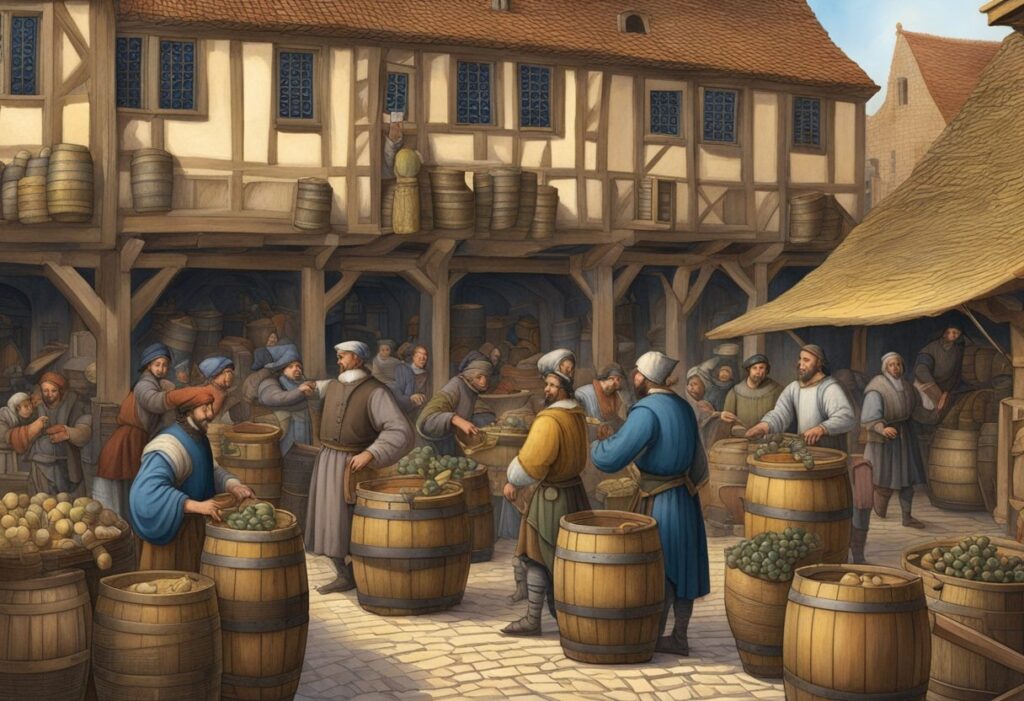
Throughout the eras, key individuals have significantly shaped the narrative of wine, blending royal influence and pioneering spirits that left an indelible mark on viniculture.
Influential Monarchs and Wine
Eleanor of Aquitaine, the influential Duchess of Aquitaine, dramatically altered the wine landscape. Her marriage to Henry II, King of England, in 1152 launched a pivotal era where the renowned Bordeaux vineyards came under English rule. This significantly boosted the popularity and distribution of Bordeaux wines.
Shakespeare not only penned plays but also alluded to wine in his works, subtly influencing its perception as a cultural symbol. His mentions contributed to the public image of wine during the Renaissance.
Pioneers of Winemaking in the New World
Thomas Jefferson, an ardent oenophile and the third President of the United States, attempted to cultivate European grape varieties in virgin American soil. His viticultural pursuits reflect the early ambition to establish winemaking in America.
The pioneers who accompanied missions and conquests played a crucial role in vine cultivation. Spanish missionaries, for example, were instrumental in introducing viticulture to the New World, bringing the Old World practices to the soils of Chile and Argentina in the mid-16th century and later to Baja California.
Technological Advancements in Wine Production
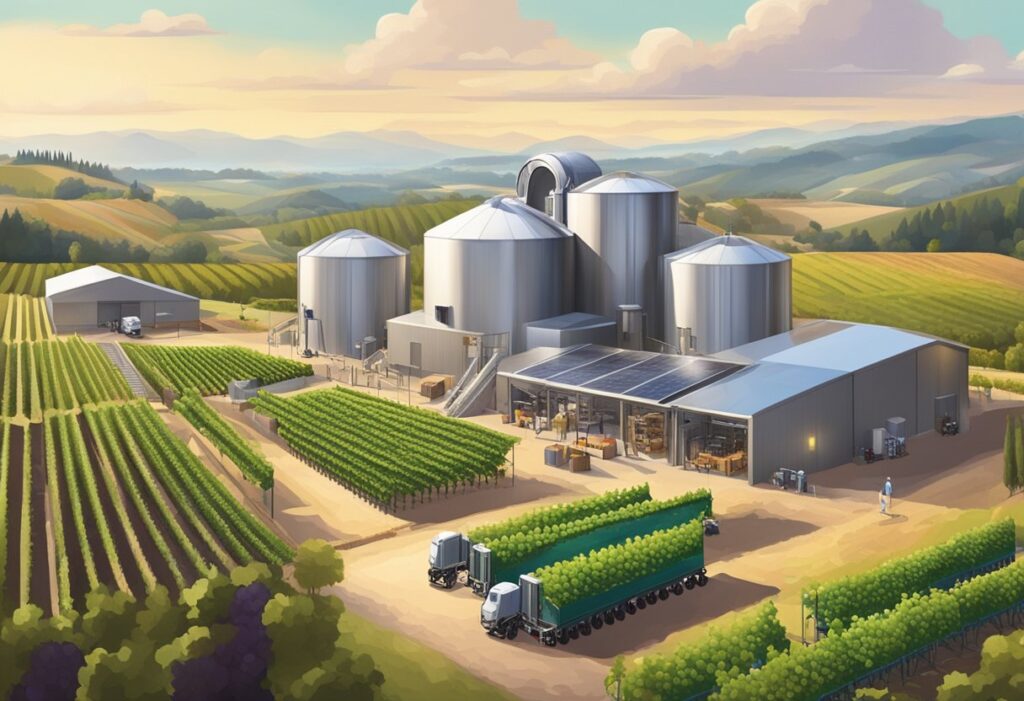
Wine production has seen a significant shift with the introduction of novel technologies that enhance both the efficiency and quality of wine. You’ll discover how modern viticulture, improved glass-making, and sustainability practices are reshaping the industry.
Modern Viticulture Innovations
Precision agriculture has become integral to viticulture, improving grape quality and vineyard productivity. Sensors and drones monitor vineyard conditions, providing real-time data on soil moisture and vine health.
This scientific approach optimizes resource usage and timing for activities like irrigation and harvesting. For example, the Wine Industry Advisor discusses how automation is enhancing these age-old practices.
Advances in Glass-making and Storage
The evolution of glass-making has brought about sleeker bottle designs and improved closure technologies, such as synthetic corks and screw caps that better preserve wine’s nuances.
Temperature-controlled stainless steel fermentation tanks have become a standard in wineries, enabling vintners to tightly control the fermentation process. Storage innovations are highlighted with insights from the National Museum of American History, emphasizing these breakthroughs.
Sustainability and Winemaking Techniques
Sustainability is no longer a buzzword but a driving force in winemaking. Renewable energy, water conservation methods, and organic farming practices are employed to reduce environmental impact.
The PA Wine Association offers perspectives on how these techniques not only support the planet but can also result in superior wine quality. You’ll find that wineries are adopting these methods to future-proof their business and cater to an eco-conscious consumer base.
The Future of Wine
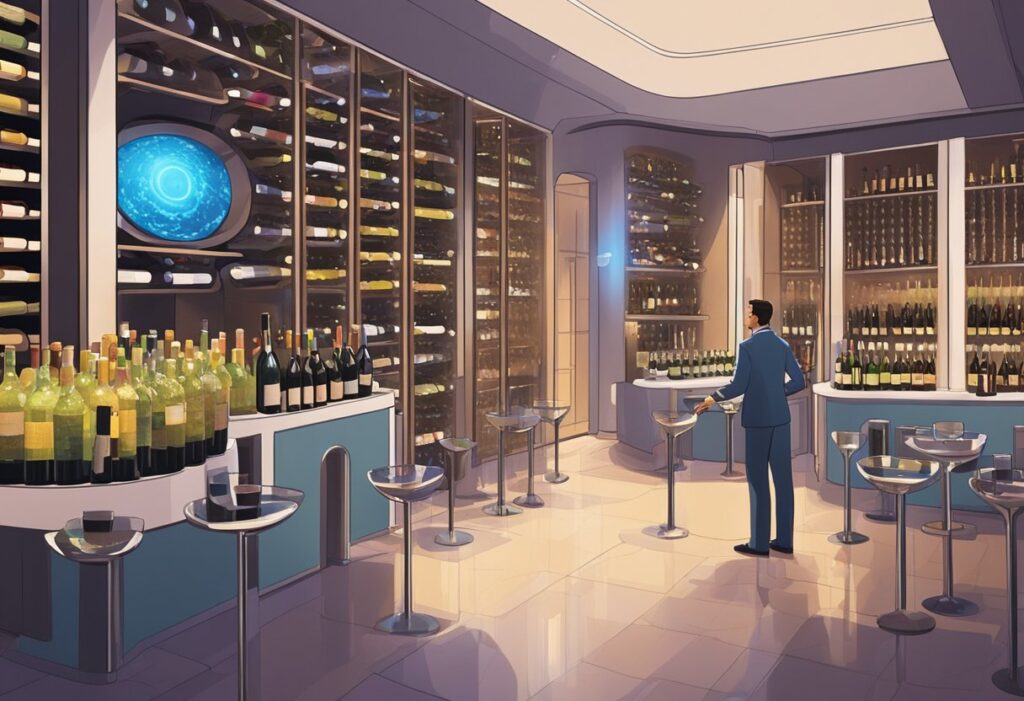
The landscape of wine is continuously evolving, with new trends taking shape, innovations advancing the industry, and education shaping the way we understand wine. Here’s what you can expect in the near future.
Emerging Trends in Wine Consumption
Today, your consumption patterns are crucial in dictating the trends within the wine industry. There’s a noticeable shift towards organic and biodynamic wines, echoing a larger social commitment to sustainability and health.
Boutique wineries are also gaining popularity, offering unique and local experiences that deviate from traditional choices.
Predictions for Wine Industry Growth
The wine industry is poised for growth, with various factors influencing its trajectory. Regions outside the traditional powerhouses of Europe are experiencing a renaissance of their own.
For instance, wines from countries such as Argentina and Chile have gained international acclaim, challenging old traditions and enticing new consumers.
Innovations in Wine Science and Education
The transmutation of wine is as much a science as it is an art. Your understanding of wine science underpins the transformations in winemaking. Cutting-edge technological advancements in vineyard management and wine production are set to heighten the quality and variety of wine.
Furthermore, education in the field is expanding, with online courses and wine-focused academic programs demystifying wine, making it more accessible than ever.

